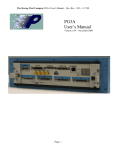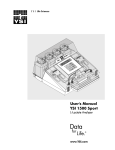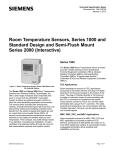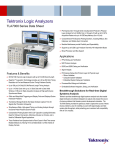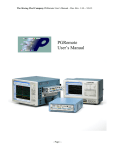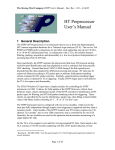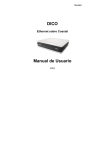Download Data Sheet and User Manual
Transcript
P373 Data Sheet and User Manual PG3A Pattern Generator P373 – LVDS probe November 2008 - Rev 1.2 1.0 General The P373 probe features 16 LVDS outputs running at up to 300 MHz as well as a clock and a strobe. To preserve the signal integrity associated with the very fast risetimes (210pS) of the output drivers, we have chosen to make the connection from the probe to the user system via a AMP Mictor connector and a high-speed, multi-coax ribbon cable. The probe expects the user system to be differentially terminated in a purely resistive 100 ohms. All specifications assume this resistive termination. The two inhibit inputs are TTL levels. There is an independent inhibit for each data byte. The probe data byte outputs are enabled when these are no-connect or pulled low. The probe does not drive the data byte outputs when the inhibit pin is driven high. 2.0 Requirements: The P373 probe works with all current PG3AMod and PG3ACab models. The instrument firmware must be V1.0 or higher. The PGApp software must be V2.0.006 or higher. Updated versions of the instrument firmware and the PGApp software can be freely downloaded from the PG3A website: www.movingpixel.com/PG3A.html. 3.0 P373 Pinouts: The pinout for the Mictor connector is as follows. We use the AMP numbering convention (as opposed to the Tektronix numbering convention found in some Tektronix documentation): Pin 1: Low Byte Inhibit input Pin 3: Low Byte Inhibit input Pin 5: Clock_p Pin 7: D1_p Pin 9: D1_n Pin 11: D3_p Pin 13: D3_n Pin 15: D5_p Pin 17: D5_n Pin 19: D7_p Pin 21: D7_n Pin 23: D9_p Pin 25: D9_n Pin 27: D11_p Pin 29: D11_n Pin 31: D13_p Pin 33: D13_n Pin 35: D15_p Pin 37: D15_n Pin 2: Strobe_p Pin 4: Strobe_n Pin 6: Clock_n Pin 8: D0_p Pin 10: D0_n Pin 12: D2_p Pin 14: D2_n Pin 16: D4_p Pin 18: D4_n Pin 20: D6_p Pin 22: D6_n Pin 24: D8_p Pin 26: D8_n Pin 28: D10_p Pin 30: D10_n Pin 32: D12_p Pin 34: D12_n Pin 36: D14_p Pin 38: D14_n The two inhibit inputs are TTL levels. There is an independent inhibit for each data byte. The probe data byte outputs are enabled when these are no-connect or pulled low. The probe does not drive the data byte outputs when the inhibit pin is driven high. The probe expects the user system to be differentially terminated in a purely resistive 100 ohms. All specifications assume this resistive termination. 3.1 Channel Associations The labeling in the PG control application (PGApp or PGAppDotNet) associated with a particular output connector on the PG correspond to the above-listed pin names as follows: Group A Group B A0[7..0] Ù Data[7..0] B0[7..0] Ù Data[7..0] A1[7..0] Ù Data[15..8] B1[7..0] Ù Data[15..8] A0(Inh) Ù Low Byte Inhibit B0(Inh) Ù Low Byte Inhibit A1(Inh) Ù High Byte Inhibit B1(Inh) Ù High Byte Inhibit Group C C0[7..0] Ù Data[7..0] C1[7..0] Ù Data[15..8] C0(Inh) Ù Low Byte Inhibit C1(Inh) Ù High Byte Inhibit Group D D0[7..0] Ù Data[7..0] D1[7..0] Ù Data[15..8] D0(Inh) Ù Low Byte Inhibit D1(Inh) Ù High Byte Inhibit 4.0 Electrical specification for the P373 probe All specifications assume 100 ohm differential load unless otherwise noted. All specifications are at 25 degrees Celsius ambient temperature, 30 minutes for stabilization of both the PG and the probe. Characteristic Output Risetime Output Enable time Output Disable time Skew, nybble Specification 210pS, typ 300nS max 12nS max +/- 65pS Notes Skew, worst case, probeprobe Clock before data +/- 550pS Output Characteristic Vod (differential voltage) Vcm (common mode) Min 250mV 1.05 V Weight Overall Dimensions 150 grams Length: 130mm, Width 80mm, Height: 29mm Yes, three hundred nS! 4 consecutive bits starting with D0 Any bit in any probe to any other bit in any other probe Within one probe, all bits 50ps – 400pS typical Typ 500mV 1.18 V Max 600mV 1.475 V approximate approximate 5.0 Backside Test Connector Pinout The P373 features a Tektronix P6980 connection from the backside to facilitate connection to a logic analyzer during pattern debug (and perhaps even during system test). Pinout: A1: D0_p A2: D0_n A3: Ground A4: D2_p A5: D2_n A6: Ground A7: D4_p A8: D4_n A9: Ground A10: D6_p A11: D6_n A12: Ground A13: No Connect A14: No Connect A15: Ground A16: D8_p A17: D8_n A18: Ground A19: D10_p A20: D10_n A21: Ground A22: D12_p A23: D12_n A24: Ground A25: D14_p A26: D14_n A27: Ground B1: B2: B3: B4: B5: B6: B7: B8: B9: B10: B11: B12: B13: B14: B15: B16: B17: B18: B19: B20: B21: B22: B23: B24: B25: B26: B27: Ground D1_n D1_p Ground D3_n D3_p Ground D5_n D5_p Ground D7_n D7_p Ground Clock_n Clock_p Ground D9_n D9_p Ground D11_n D11_p Ground D13_n D13_p Ground D15_n D15_p 6.0 Pre-emphasis The P373 probe has the ability to add pre-emphasis to the output signals. There are three jumpers accessible from the bottom of the probe that allow you to select pre-emphasis. Pre-emphasis is useful if you are driving long, lossy wires (greater than a couple of feet). Jumper J5: pre-emphasis control for Clock and Strobe. ON is toward the J5 silkscreen. Jumper J3/ Jumper J2: pre-emphasis controls for the data. Both off (away from the J3/J2 reference designator silkscreen) is pre-emphasis off. Binary selection for more preemphasis (low, medium, and high). J2 is the most significant bit. Figure 1 P373 Pre-emphasis Jumpers 7.0 Other useful information: Part number for a connector that will mate with the probe output cable: Amp 767054-1 Part number of the probe output cable: Tyco/Precision Interconnect 913850038015AA21 The LVDS driver we use inside the probe is the National Semiconductor DS90LV004. Data on this device can be found at http://cache.national.com/ds/DS/DS90LV004.pdf. If a user system does not need to run at the highest speeds the probe supports and does not want to connect to the user system via a Mictor, there are adapters available for Mictor to square pins like the Nexus Technology Nex-HD20 (http://www.nexustechnology.com/products/laAccessories/hd20/). Using an adapter from the Mictor will like cause signal integrity to suffer as the risetime on the output of the probe is typically 210 pS. Uncontrolled impedances of longer than 5mm will be noticed in the waveform. Uncontrolled impedances of longer than 3 cm may make the signal unusable, especially the clock signal. Also note that all the probes except the P300 can be stacked on top of each other. Metal inserts are provided in each side of the probe for assisting in probe mounting. The screw thread is a UNC #4-40. Any screw thread inserted into this should not exceed 0.25 inches in length else the probe could be damaged.








